What has the world come to? Fire and brimstone falling from the skies, little red devils running through the streets wreaking havoc, and watching the peaceful islands and plains burn from the comfort of my personal computer at home helplessly via SCG Live. Enough is enough. After GP Moscow, the Columbus Invitational, and the Standard Open that same weekend all falling to the power of red, I know we are in for a rough month or two. Red decks are so cheap to build and are played enough already online and in live magic, but now that Mountains have wrapped up a few big tournaments in a row that popularity is going to skyrocket.
Typically these red decks are hated out by the midrange decks that drop more powerful creatures than the red decks in the early turns, stopping the onslaught of the little dorks that Koth of the Hammer’s fans choose to summon. This is not the case anymore. Green decks with Courser of Kruphix are still a favorite against Boss Sligh, Mono Red Aggro, and R/W Burn decks that are threatening the fabric of Standard. People will figure that out soon enough, but in the meantime control mages will be running for their lives against the red menace that will turn these next few months into a Standard Dark Ages.
The history nerd in me comes out when discussing the health of Standard as seen from the eyes of a control mage, and I personally relate these problematic times to either a Dark Ages or the return of control dominance to a Renaissance. People understand the power of Sphinx’s Revelation, Detention Sphere, Supreme Verdict, and so on and so forth. The ongoing reputation that these cards are too good is great and all, but the question then is: why aren’t they winning events? If you take a trip down memory lane over the last couple of years, you’ll notice a disparity between control’s successes lately compared to its dominance in formats of old. Control will never take down tournament after tournament, because it is just not the most-played archetype historically. You’ll see waves of midrange and aggro decks absorb the majority of the field’s metagame, so control typically will have two or three slots in a Top Eight and may take it down when the format is friendly to the board-sweeper strategy. These days it is a shock when even just one U/W Control deck is in the Top Eight of a Pro Tour, Invitational, GP, or even an Open. There are players like Patrick Chapin who prefer the control strategy but will adapt and switch to achieve victory when the water is full of aggressive sharks. Then there are players like me that will sink, get ripped apart by said sharks, and with my dying breath hold up a Supreme Verdict above water. So what are we to do in this era of seventeen-Mountain decks? We will do whatever it takes to give us the best shot to fend off the invading hordes.
Identify the Enemy
Mono Red, and decks very much like it, are the new thing to consider when sculpting our maindeck and sideboard. I have played ten matches of Standard in the heads-up queues on Magic Online after last weekend, and seven were Mono-Red. I also played three eight-mans online, faceing Mono-Red another four times. The struggle is real, my friends, and luckily with this augmentation of Esper we have a fighting chance. The decklist from the last article is going to be relatively unchanged, but the manabase will become a little less punishing while the sideboard will be stacked to defeat those evildoers. The real element of concern is the amount of threats that come out very quickly. One-drops are typically the control deck’s bane, especially in a format where we depend on so many lands that enter the battlefield tapped. I added an extra basic land, but any more land changes will hurt the manabase more than I’m willing to allow.
The important fact to remember is that even though the dark clouds have stretched across the standard metagame, there are other decks out there that can still beat us. You’ll notice I never change my decks very drastically in order to defeat one hot deck of the month or a recent victor in a big tournament, but to do nothing at all would be foolish here.
Do people play decks just because they win something? Yes. Mono Red sweeping a weekend is the catalyst for a metagame shift that has been some time coming, but there are other perks of the deck. I will give my opinionated, biased, but fairly accurate rundown on why people will play Mono Red.
Firstly, the deck is like twenty bucks. Standard isn’t Legacy, but it can still get a little pricey. I understand this reason completely. Back before I was old, I had to scrounge to get the cards to play Squirrel Opposition and it was a nightmare. There were many times I had to settle for different decks and subpar cards, then suffer through tournaments in a depressing fashion. That was in a time where there were no mythics and cards didn’t typically exceed fifteen or twenty dollars. These days there are cards that are worth more than the entire Mono Red deck. Tom Ross won ten thousand dollars with a twenty dollar deck, GP Moscow was won with a low-costed red variant also, and the Standard Open was yet another example of cheap victory. I won’t be able to dissuade people from choosing this aggro strategy with cost or results at this point, so it’s best for us control mages to push for GW, and similar midrange green decks, to gain momentum. The enemy of our enemy is an ally, my friends.
Secondly, the deck is easy to play. This one always sparks a conversation. I always have wonderful, long debates with Patrick Sullivan over this topic or another, similar one. You play some dorks, attack with dorks, pump dorks, burn opponents, you rinse and repeat. Although I haven’t played a lot of Mono Red Aggro (except for that one time), I have played against it around three million times… and since it always goes down to the last card I have a relatively good idea how each turn unfolded and how it could have been different. A skill in magic is to be very aware of opponent’s plays and how those plays could have developed in other ways… this gives you so much more insight to how a matchup plays out for the future. There are times where my opponent cast Lightning Strike at me at the end of turn instead of their main phase. Sometimes my opponents cast Titan’s Strength on their Ash Zealot instead of their Firedrinker Satyr and that seemed to be a tough decision. Sometimes it’s tough to convey sarcasm in writing, so I’ll clarify that I am indeed being facetious. The biggest difficulty in piloting red decks is when facing decks that have a lot of creatures, but even then I’ve witnessed these matchups and the decision tree is still pretty branchless. It almost has the feel of a very good limited deck, but much easier to operate due to the quickness of the games. Typically Limited games last longer than turn five or six, which is the total lifespan of the seventeen-Mountain decks. I will concede the fact that a mistake made in the aggro world is more often detrimental when compared to a control deck’s mistakes. I have played the wrong land, killed the wrong creature, screwed up the order of spells, and still achieved victory. If you goof (somehow) in the early aggro turns, then your chances of victory could instantly dissolve.
Third, there’s this: No time to playtest? No problem! When playing midrange and control decks, you typically need to playtest to understand card interaction more so than with other archetypes. This doesn’t mean that playtesting with aggro decks doesn’t yield results, but the lack of preparation won’t kill your chances of success. My buddy Ali Aintrazi played zero playtested games with Mono Red Aggro (in Legacy for God’s sake!) and easily cruised into the Top Eight of an Invitational not too long ago. That type of red deck is different from the standard version, obviously, but the overall gameplan is similar. It is all about pushing damage through until you can get that last point across and achieve victory, and in Standard it is done by many, many creatures. I admittedly played Boss Sligh earlier this year and had a stellar 3-0 start. I then proceeded to lose back-to-back to Mono Blue Devotion with eight creatures maindeck that “hate” on red. I would never consider myself a master of aggro, but the three victories at the beginning were against big players in the metagame (Mono Black Devotion, R/G Midrange, and UW Control) and I didn’t suffer from a lack of playtesting. Magic is a skill-intensive game, so don’t get me wrong: if you play like crap then you’ll lose, regardless of your deck choice. Tom Ross, who is a great Magic player, played red and won it all… and Patrick Sullivan is also phenomenal and he has had many a success in his day with this strategy. If you want to join the likes of these aggro masterminds then you’ll have to playtest, but if you want to earn a little cash, maybe Top Eight the Open Series, and don’t have time to practice, kick Esper to the curb and buy your Madcap Skills.
Fourth, it beats decks without green. If you aren’t packing Courser of Kruphix then you are an underdog. There are some starts that Mono Red has that are just unbeatable for us, but luckily we are playing Magic: the Gathering and they don’t always “have it”. If they are on the play and drop a Firedrinker Satyr, then an Ash Zealot, then a Madcap Skills and Legion Loyalist… we are probably dead. Playing seventeen lands luckily makes mulliganing inevitable and that provides us some hope that the nut start is unlikely. The bad news remains the same, which are these decks don’t need the best possible start to beat most of the control draws at least in the first game. I witnessed Tom Ross beat Alex Bertoncini in the semifinals, but Alex played like seven spells in three games due to mana issues (flood, screw, screw). I don’t think Tom wins that best-of-five set most of the time, but we play a game with a random element and that’s what makes it great. If you watched the rest of Tom’s games throughout that Invitational, you probably noticed a pummeling of decks without green with extreme prejudice. I’m not delusional and I know that when my opponent plays a mountain and a one-drop that bad things are coming. People will pilot this archetype in the next few events and ride the wave of red, making the life of us control mages just that much more difficult.
Creatures (5)
Planeswalkers (6)
Lands (27)
Spells (22)
- 4 Thoughtseize
- 4 Supreme Verdict
- 4 Detention Sphere
- 4 Sphinx's Revelation
- 1 Ultimate Price
- 3 Devour Flesh
- 2 Hero's Downfall
Sideboard

What Do We Do?
Surrender is not in my vocabulary. When faced with a great enemy, a sea filled with evil, the control heroes must adapt accordingly. In ancient days we had an easy fix like Kor Firewalker that made Goblin Guide look like a chump. In today’s world we have Fiendslayer Paladin and Brimaz, King of Oreskos. Since the three drops put the brakes on one-drops, our two-mana strategy has to be tight. The sideboard still has three Doom Blades in it, but the maindeck has been edited to cheapen the removal package. It is set up in a way that after we have lost Game One, Game Two and Game Three should be ours for the taking. There are some that will question the four Thoughtseize, Aetherling, Devour Flesh, and general slow strategy that the maindeck presents, but we have to remember that we will not face Mono Red every round and we still have to remain competitive against the field. Sure, we could cut the Thoughtseizes, and we could play targeted removal instead of sacrifice effects, but we will probably still lose that first game to Mono Red. The maindeck is tuned to the best of my ability to have a small shot against Mono Red but remain powerful against everyone else. Sometimes you can just Supreme Verdict and play a Blood Baron of Vizkopa and the game is over against the burn menace, so don’t give up completely.
The third basic Island was added in place of a Temple of Silence. I have toyed with adding even more basics, but there were too many games where the manabase was uncooperative. This is another example of doing the best we can with the maindeck, but really hammering out the matchup from the sideboarded perspective. The sideboard has three Fiendslayer Paladins, three Doom Blades, and two Blood Baron of Vizkopa that come in against Mono Red to fight on the side of good. Nyx-Fleece Ram was a short-lived, cute card for me. It does less than Fiendslayer Paladin in every aspect of the matchup and being only one mana cheaper isn’t enough of a deal to sacrifice all of that first strike and protection.
Fiendslayer Paladin is easily the all-star of the matchup and if deployed on turn three after a removal spell it hearkens that victory is near. I tried to find cards that were decent against other matchups as well, and they couldn’t fill the void that Fiendslayer Paladin left when absent. The only threatening card after we resolve the lifelinking hero is Ash Zealot, and that’s it. Titan’s Strength doesn’t provide enough toughness to get their creature through, and since all of red’s creatures are so dinky, alpha strikes are rarely advantageous in that situation. Blood Baron of Vizkopa is also very good against them in both regular and sideboarded games because of his size and resilience against a single removal spell. If they are tossing a creature and a burn spell at our vampire, then our chances of victory increase. Just one chance to trade for some of their cards and gain four life in that matchup can be enough to win on the back of all of the other support spells you are slinging at them in a frantic survival strategy.
There are a few fairly obvious cards that have to be boarded out. The win conditions against red have to be cheap, so the first cards to be cut are the Aetherling and both copies of Elspeth, Sun’s Champions. After sideboarding, Esper is rocking four copies of Blood Baron of Vizkopa, two copies of Brimaz, King of Oreskos, and three Fiendslayer Paladins. That creature suite is easily up for the job of defeating an opposing blitz strategy. Even a card like Brimaz, King of Oreskos is fantastic against Mono Red and does work in both blocking and attacking.
Besides taking out the slow win conditions, there are a few stinkers left in the form of Thoughtseize. Taking damage and wasting mana in order to possibly save one damage and have some information about their hand isn’t worth it. It’s not absolutely a dead card, but it’s easily the worst option against a blitz deck. So the official sideboard plan is:
IN:
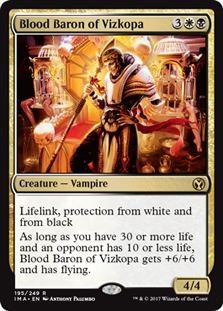

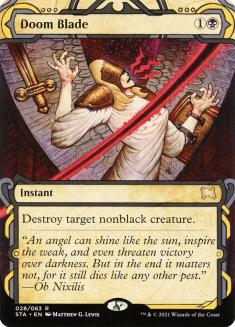


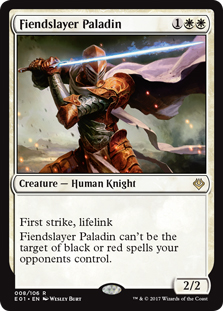


OUT:




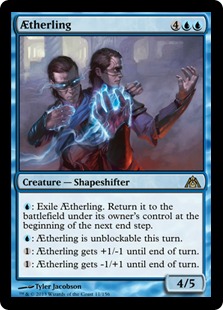
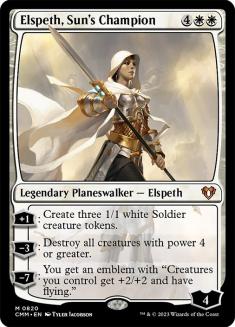

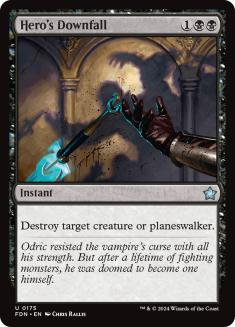
The Hero’s Downfall is the only card that you may question in the sideboard plan, but the three-slot gets very crowded after board. With Fiendslayer Paladin, Detention Sphere, Brimaz, King of Oreskos and Hero’s Downfall, the three-mana club needs to cut a member. I have from time to time cut a Devour Flesh because it can be blanked by the token creatures red can produce, but more often the Hero’s Downfall was the least-effective card. There are arguments for cutting one Sphinx’s Revelation or a land, but I like to keep the end game as fully intact as possible to avoid losing games that were in the bag otherwise. It is up to the few loyal warriors of control to maintain the peace and not let red have its way with multiverse. Red blitz variants are like a virus that will replicate over and over with each successful showing. Don’t leave your house, enter a queue online, or even play casually with a friend without having the necessary tools and plans that it takes to push us from this looming Dark Age back into a Renaissance with the glory of control rising once again. Hopefully by the time you all read this I’ve won the GP here in Chicago, but regardless… you all know I practice what I preach.
